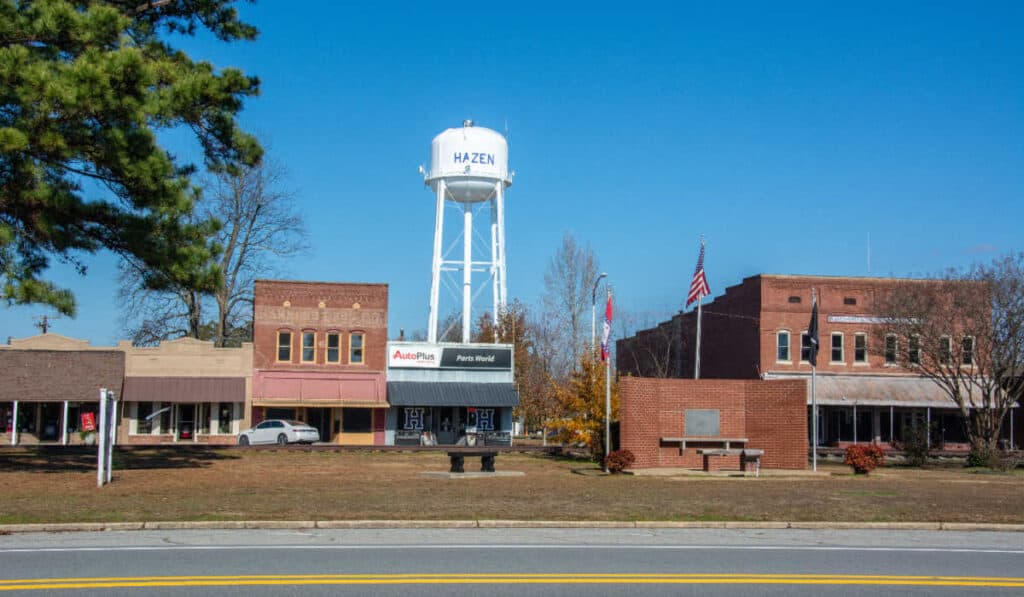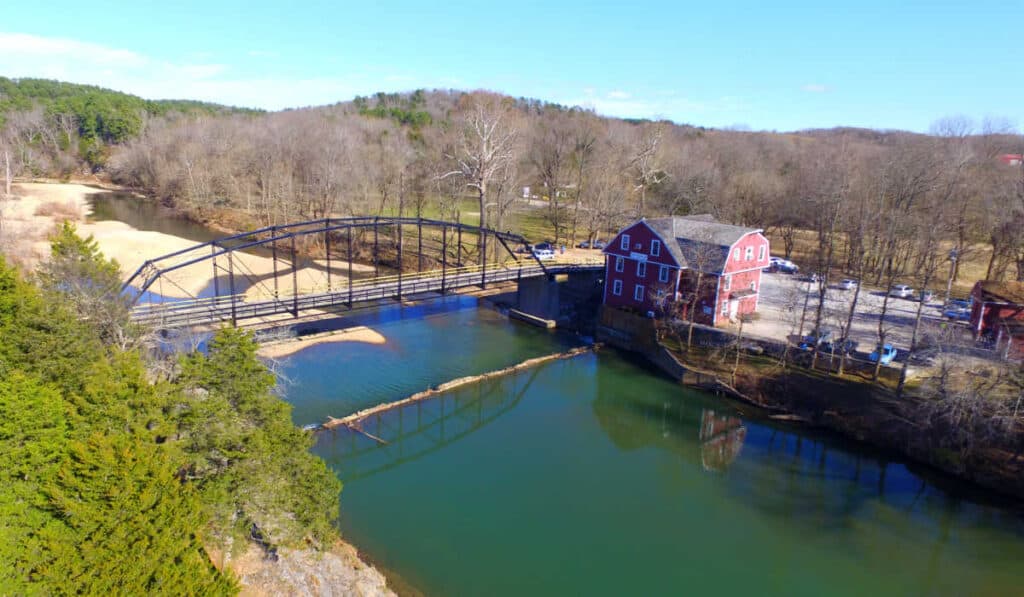Missouri, known as the Cave State, boasts an impressive array of approximately 7,500 recorded caves, making it a top destination for spelunkers and cave enthusiasts alike. A significant number of these captivating caves are located in the Ozark region, offering visitors a chance to explore the state’s unique geological features. The caves can be broadly classified into two categories: commercial or show caves and wild caves.
Show caves in Missouri are divided into state or federally-run caves and privately-owned caves. These caves often have guided tours, providing fun and educational experiences for visitors. Some popular examples include Onondaga Cave and Cathedral Cave at Onondaga Cave State Park, Fisher Cave at Meramec State Park, and Ozark Caverns at Lake of the Ozarks State Park.
In contrast, wild caves present a more adventurous and challenging experience, often requiring specific skills and equipment. These caves provide an opportunity for experienced cavers to delve deeper into Missouri’s underground world. However, it is essential to note that many wild caves used by bats in the state park system are temporarily closed to help prevent the spread of a fungus that harms bats, but does not affect humans.
Missouri: The Cave State
Karst Landscape and Geology
Missouri is known as “the Cave State” because it is home to over 7,000 recorded caves, making it a significant location for cave enthusiasts and researchers alike. The prevalence of caves in Missouri is due to its karst landscape, which is characterized by porous limestone and dolomite formations. This geology creates features like caves, springs, sinkholes, and natural bridges, providing unique habitats for a variety of plant and animal species.
Many of Missouri’s caves are found in the Ozarks region, particularly in Shannon County, which holds the title for the most caves in a single county with over 730 recorded examples. These caves can range in length from 20 feet to more than 30 miles of mapped passages.
Types of Caves: Show Caves vs Wild Caves
There are two main categories of caves in Missouri: show caves and wild caves. Show caves are open to the public for guided tours, providing visitors the opportunity to experience the state’s underground beauty firsthand. Currently, there are 20 show caves in Missouri, including popular attractions like Onondaga Cave and Cathedral Cave at Onondaga Cave State Park, Fisher Cave at Meramec State Park, and Ozark Caverns at Lake of the Ozarks State Park.
Alternatively, wild caves are not open to the public and remain largely undisturbed by human activity. Wild caves in Missouri are often inhabited by bats. In order to protect these animals from the spread of a fungus that harms bats but does not affect humans, many wild caves have been temporarily closed to the public.
Conservation and Research

Missouri’s caves are not only geological treasures but also essential habitats for various plants and animals, including threatened and endangered species. As a result, conservation efforts are crucial to ensure the continued protection and preservation of these unique underground ecosystems.
Organizations like the Missouri Department of Conservation and the Missouri Department of Natural Resources are responsible for managing and protecting the state’s cave resources. Alongside these management efforts, scientific research is conducted to expand our understanding of cave-dwelling species, such as bats, and the geological processes that have shaped the Missouri landscape.
Famous Caves and Attractions
Onondaga Cave and State Park
Onondaga Cave and State Park, located in Leasburg, Missouri, is home to the beautiful Onondaga Cave. It offers guided tours to showcase its impressive formations, including stalagmites, stalactites, and flowstones. This cave is a perfect destination for nature enthusiasts and families looking for an educational and awe-inspiring experience.
Fantastic Caverns
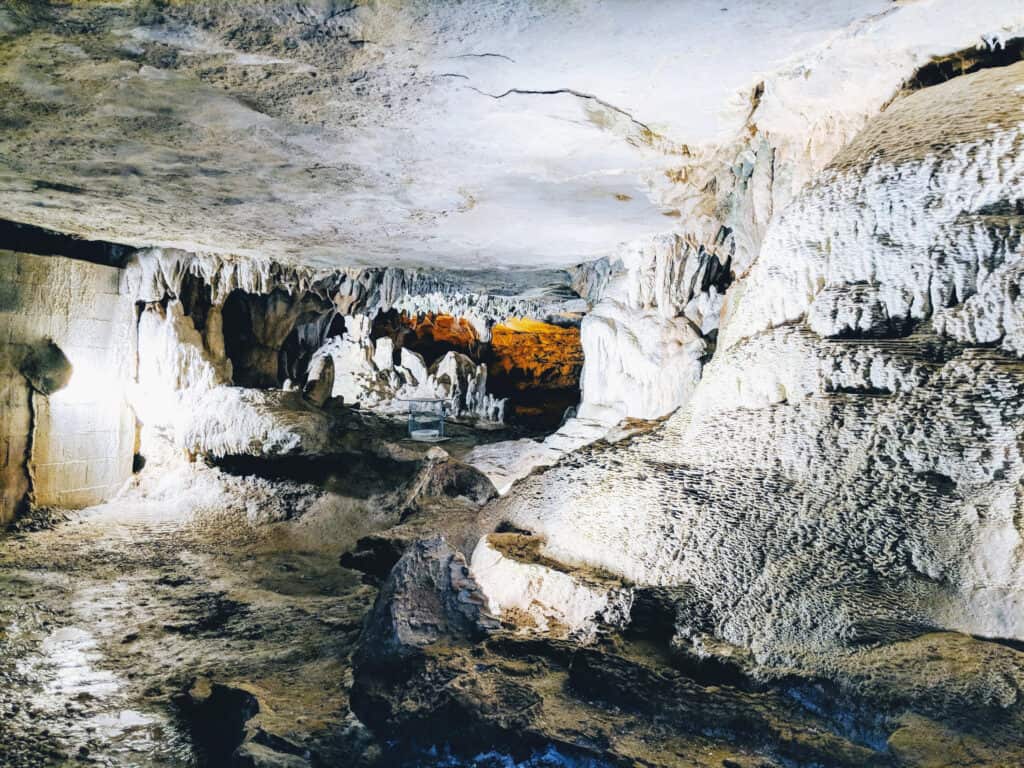
Fantastic Caverns, situated near Springfield, is a unique cave attraction in Missouri. It offers drive-through tours that allow visitors to explore in the comfort of their vehicles. The caverns gained notoriety as a hideout for the infamous outlaw Jesse James and serve as a fascinating piece of history.
Marvel Cave and Silver Dollar City

Marvel Cave, located in Branson, is part of the famous Silver Dollar City amusement park. As the deepest cave in Missouri, it features nearly 600 stairs and a stunning Cathedral Room 300 feet below the surface. The cave tour is quite strenuous but offers a breathtaking experience of this National Natural Landmark.
Mark Twain Cave
The historic Mark Twain Cave in Hannibal, Missouri, is a must-visit attraction for literature lovers. This cave served as the inspiration for the fictional McDougal’s Cave in Mark Twain’s famous novel The Adventures of Tom Sawyer. Visitors can take guided tours and immerse themselves in the world of Tom and Huck while exploring the cave’s fascinating geology.
Bridal Cave
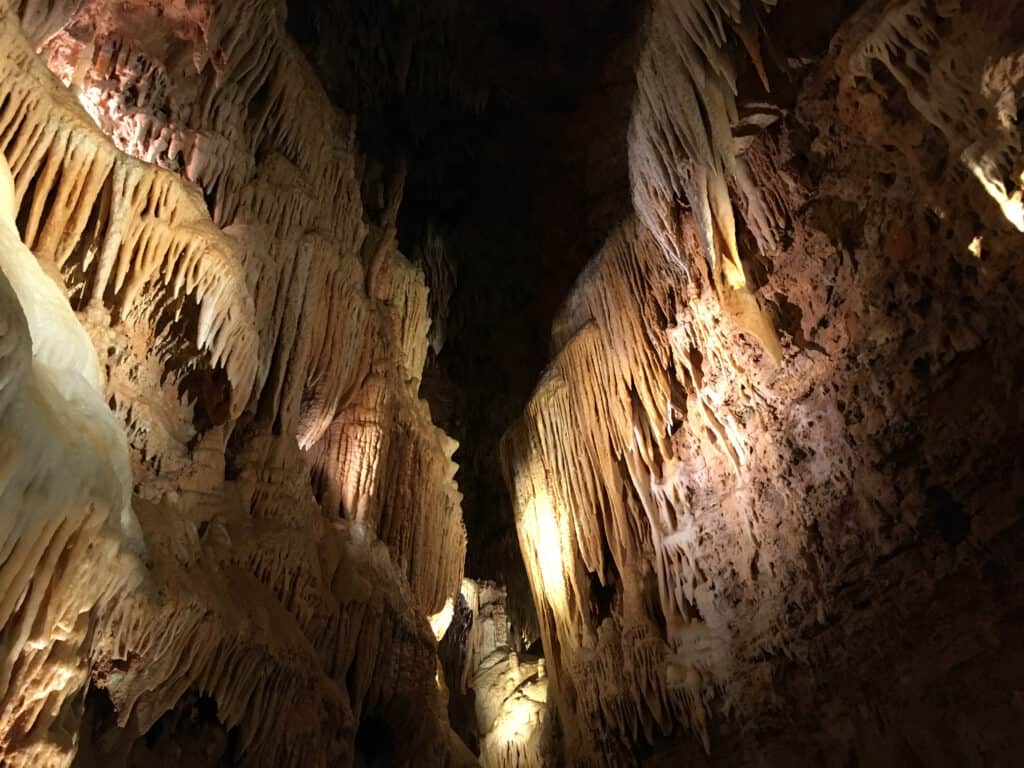
Located under Thunder Mountain near Camdenton, Bridal Cave is a popular wedding destination with a romantic legend. The cave’s name originates from a Native American wedding that is said to have taken place there centuries ago. With its stunning formations and enchanting atmosphere, it offers visitors a unique and memorable experience.
Meramec Caverns
Meramec Caverns are the most famous caves in Missouri, attracting over 150,000 visitors annually. Located in Stanton, the caverns are renowned for their billboards advertising along Interstate 44. Visitors can take part in guided tours and explore the intricate formations and subterranean wonders that make this cave system a beloved attraction.
Cave Formations and Unique Features
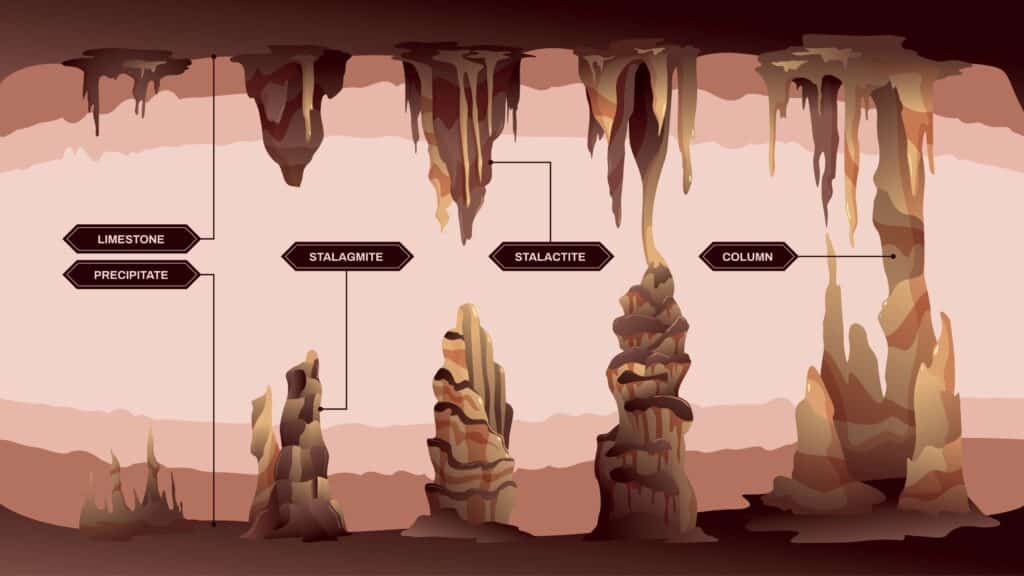
Missouri is home to over 7,000 caves, earning it the nickname “the Cave State.” Many of these caves contain fascinating and diverse formations, thanks to the state’s karst landscape of porous limestone and dolomite.
Stalactites, Stalagmites, and Columns
Stalactites are icicle-shaped formations that hang from a cave’s ceiling, while stalagmites are cone-shaped formations that rise from the floor. Both form due to the slow dripping of mineral-rich water. When stalactites and stalagmites eventually meet and grow together, they create columns that serve as natural pillars within the cave system.
Soda Straws and Helictites
Soda straws are a type of delicate, hollow stalactite. They form as mineral-rich water drips from the cave’s ceiling and leaves behind thin, tube-like structures. Over time, the tubes can become blocked with minerals, leading to the growth of solid stalactites.
Helictites are twisted, curving formations that can grow in any direction within a cave. Their unusual shapes are a result of capillary forces and hydrostatic pressure causing the mineral-rich water to flow in unexpected paths, creating these distinctive features.
Flowstones, Draperies, and Angel Showers
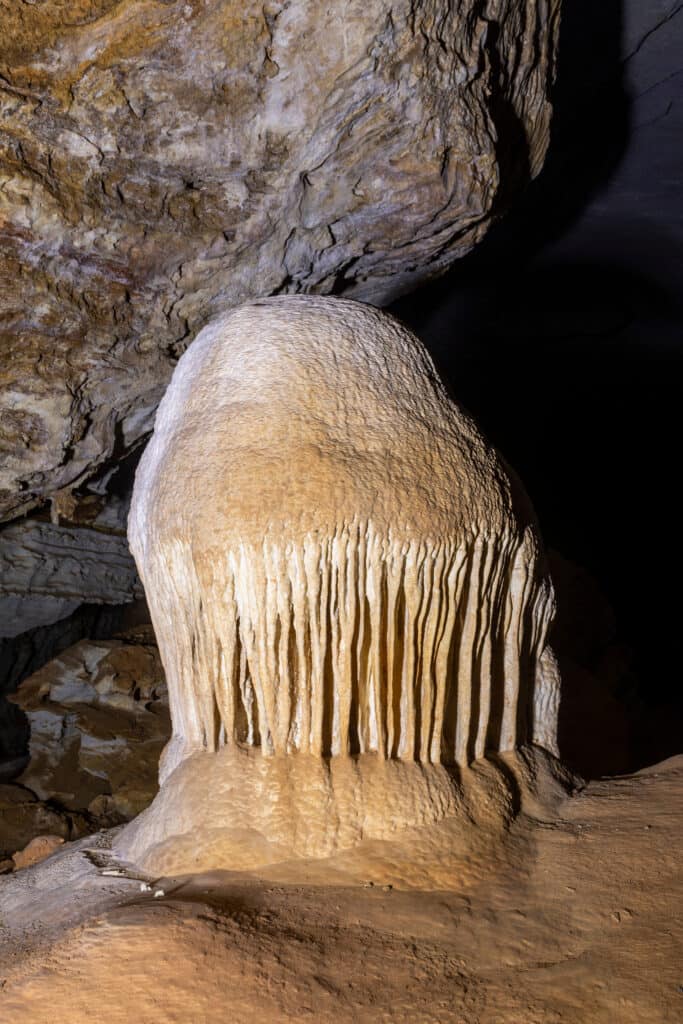
Flowstones are formed by the movement of water over cave walls and floors, allowing thin layers of minerals to be deposited over time. This process creates a smooth or rippled layer of stone that resembles cascading water.
Draperies, also known as cave bacon or curtain formations, are thin sheets of mineral deposits that hang from cave ceilings or walls. They form from water running down inclined surfaces, leaving behind layers of minerals resembling curtains or folded fabric.
Angel showers are a unique and rare type of cave formation found primarily in Missouri caves. They consist of clusters of stalactites suspended from a single point on the cave ceiling, resembling a collection of hanging icicles. These delicate formations take thousands of years to develop and are a breathtaking sight to behold.
The diverse and intriguing array of cave formations in Missouri attracts visitors, spelunkers, and researchers alike, showcasing the state’s geological wonders and contributing to its rich natural heritage.
Cave Life and Ecosystem
Missouri is home to more than 7,000 caves, and these caves are home to a diverse range of living organisms and unique geological formations. In this section, we will explore the life found within Missouri caves, focusing on fish, crayfish, invertebrates, salamanders, bats, fossils, and geologic history.
Fish, Crayfish, and Invertebrates
Missouri caves are inhabited by various species of fish, crayfish, and other invertebrates. Some species have adapted specifically to the cave environment, like the grotto sculpin, a rare type of fish found only in a few cave systems in the state. Cave crayfish frequent many of Missouri’s caves, and they play an essential role in the cave ecosystem by serving as a primary food source for other cave-dwelling creatures.
A diverse array of invertebrates can be found in these cave systems, including various species of cave spiders, millipedes, and amphipods. For a more comprehensive guide to Missouri’s cave life, you can refer to the Missouri’s Cave Life identification manual.
Cave Salamanders and Grotto Salamanders
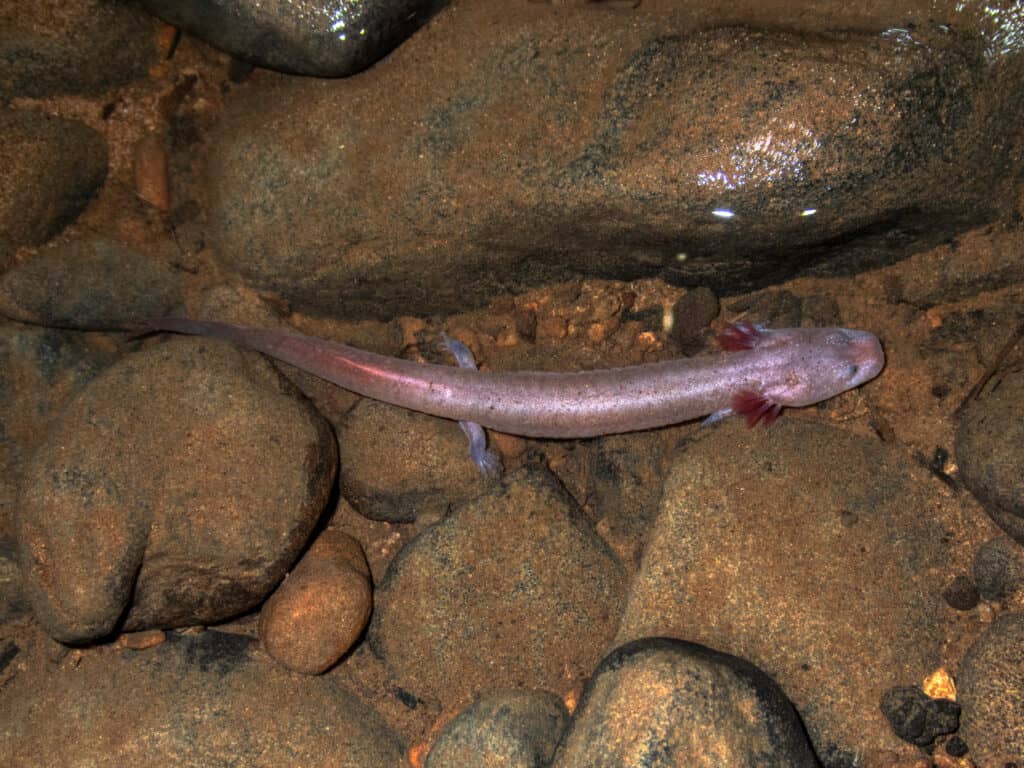
Cave salamanders, which are amphibians specially adapted to live in the dark and moist cave environment, are an essential part of Missouri’s cave ecosystems. The grotto salamander is a particularly unique species endemic to the Ozark region. These salamanders are known for their distinctive external gills and lack of eyelids, which indicate their adaptation to their subterranean habitat.
Bats and Hibernation
Bats are perhaps the most well-known cave inhabitants and are essential to maintaining healthy ecosystems both within and outside the caves. Due to their ability to consume thousands of mosquitoes and other pests each night, they help control insect populations. Many bats hibernate in Missouri caves during winter months, relying on the stable temperatures and protected environment offered by these subterranean spaces.
Fossils and Geologic History
Missouri caves not only house an array of living creatures but also contain valuable information about the geological history of the region. Fossils preserved within cave systems offer clues to the past fauna and flora, helping researchers understand past climate changes and ecological shifts. The Cave Research Foundation contributes to the understanding of the caves, preserving them, and protecting these unique geologic formations while also ensuring the continuation of the important ecosystems they support.
Cave Exploration and Tours
Missouri is home to many fascinating caves and caverns, offering a variety of experiences for visitors and locals alike. This section will cover Family-Friendly and Accessible Tours, Lantern Tours and Specialty Tours, Wild Cave Exploration, and provide advice on Safety, Clothing, and Footwear.
Family-Friendly and Accessible Tours
Missouri has several family-friendly cave tours that cater to a wide range of audiences. Fisher Cave at Meramec State Park and Ozark Caverns at Lake of the Ozarks State Park are two excellent options for visitors of all ages. These show caves provide guided tours, making the experience both educational and entertaining.
For those with mobility limitations, some cave tours are wheelchair accessible, ensuring that everyone can enjoy the beauty of Missouri’s underground wonders.
Lantern Tours and Specialty Tours
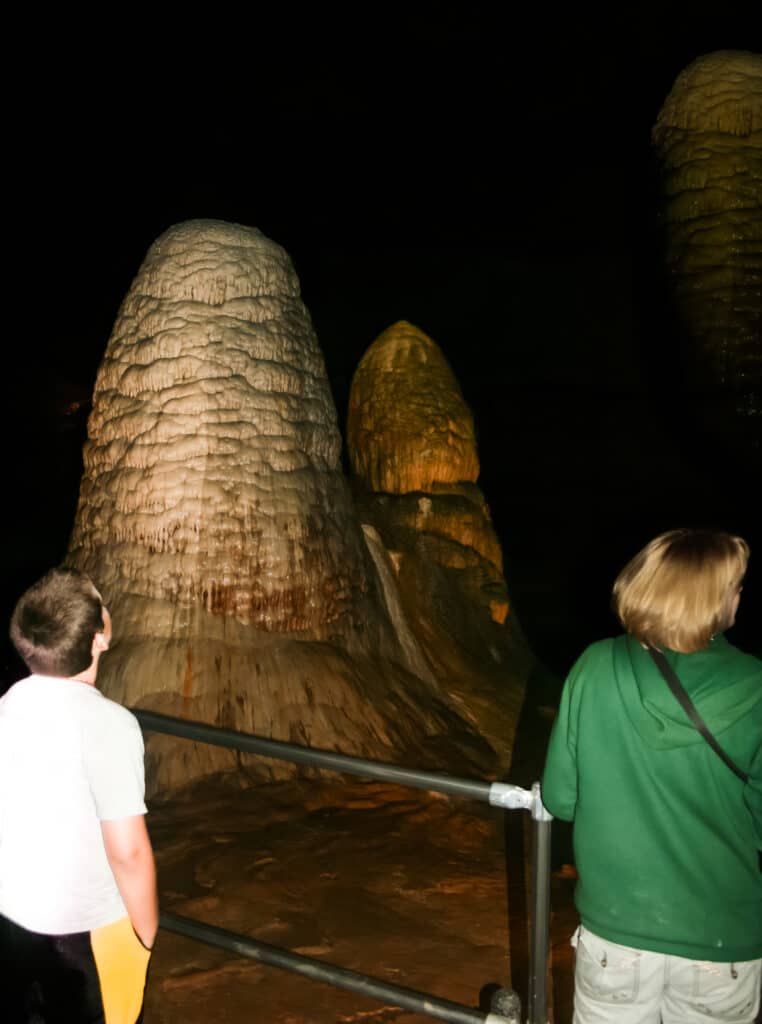
A unique experience, lantern tours offer visitors the opportunity to journey through caves by the light of lanterns, just as early explorers did. This type of tour is available in caves such as Cameron Cave, where Native Americans historically used the cave for shelter.
Theme parks, such as the Silver Dollar City Theme Park, sometimes offer specialty tours, which can include caves filled with interactive exhibits, museums, and even indoor springs for visitors to explore by boat.
Wild Cave Exploration
For the more adventurous, wild caves in Missouri provide an opportunity to explore caves in their natural state. Unlike show caves, wild caves are not developed for tourism and should only be visited by experienced cavers. Exploring these caves without professional guidance could result in harming fragile cave ecosystems and the many cave creatures, such as grotto salamanders, that call them home.
Before venturing into wild caves, it is important to check for any closures due to the spread of fungus that can harm bat populations during hibernation.
Safety, Clothing, and Footwear
When planning a cave exploration or tour, it is important to prioritize safety. Ensure you are well-prepared by familiarizing yourself with the cave’s specific rules and regulations. Wear appropriate clothing, such as long sleeves and pants, to protect yourself from sharp rocks and potential insects. Footwear should provide ample support and traction for navigating the often damp and uneven terrain. In addition, some caves feature stainless steel railings to help visitors navigate the most treacherous paths, such as the dramatic Rock of Ages formation of Cathedral Cave.
Armed with this knowledge, you are ready to experience the breathtaking underground beauty of Missouri’s caves and caverns.


